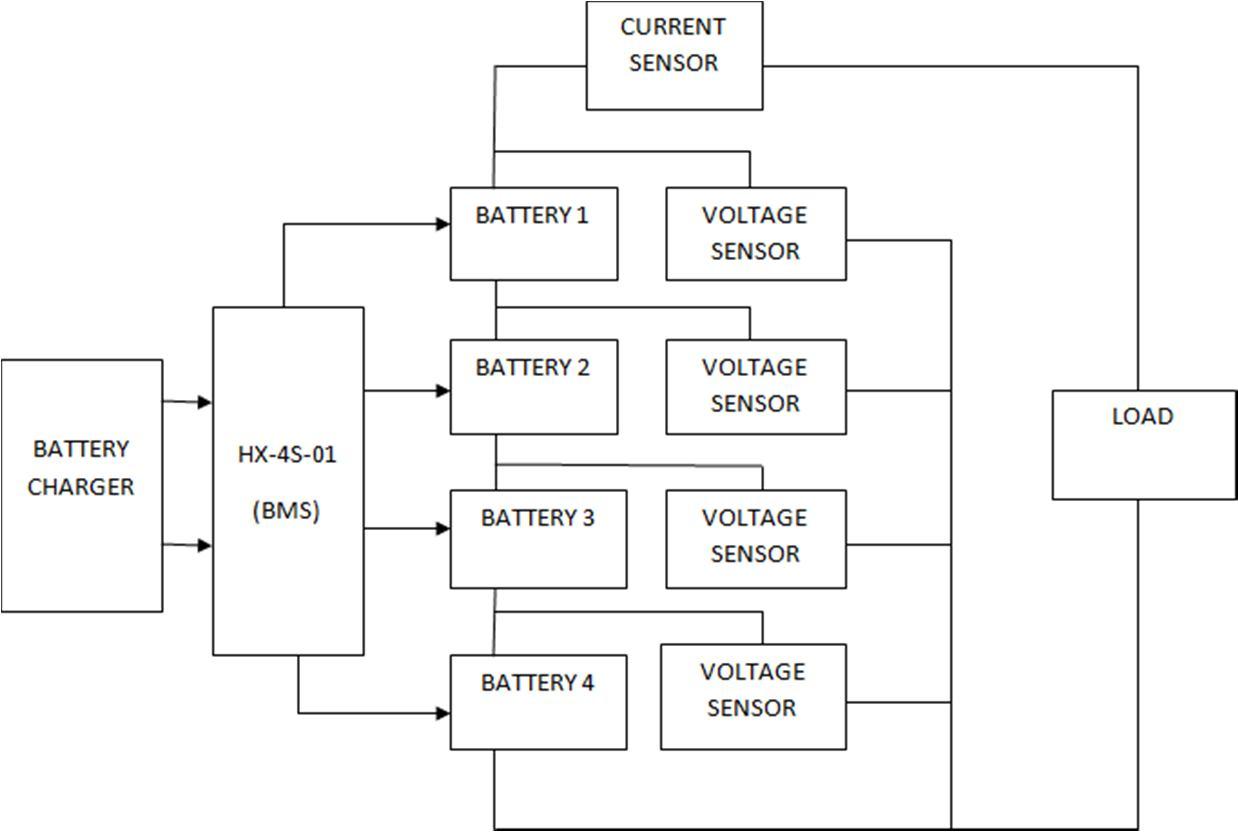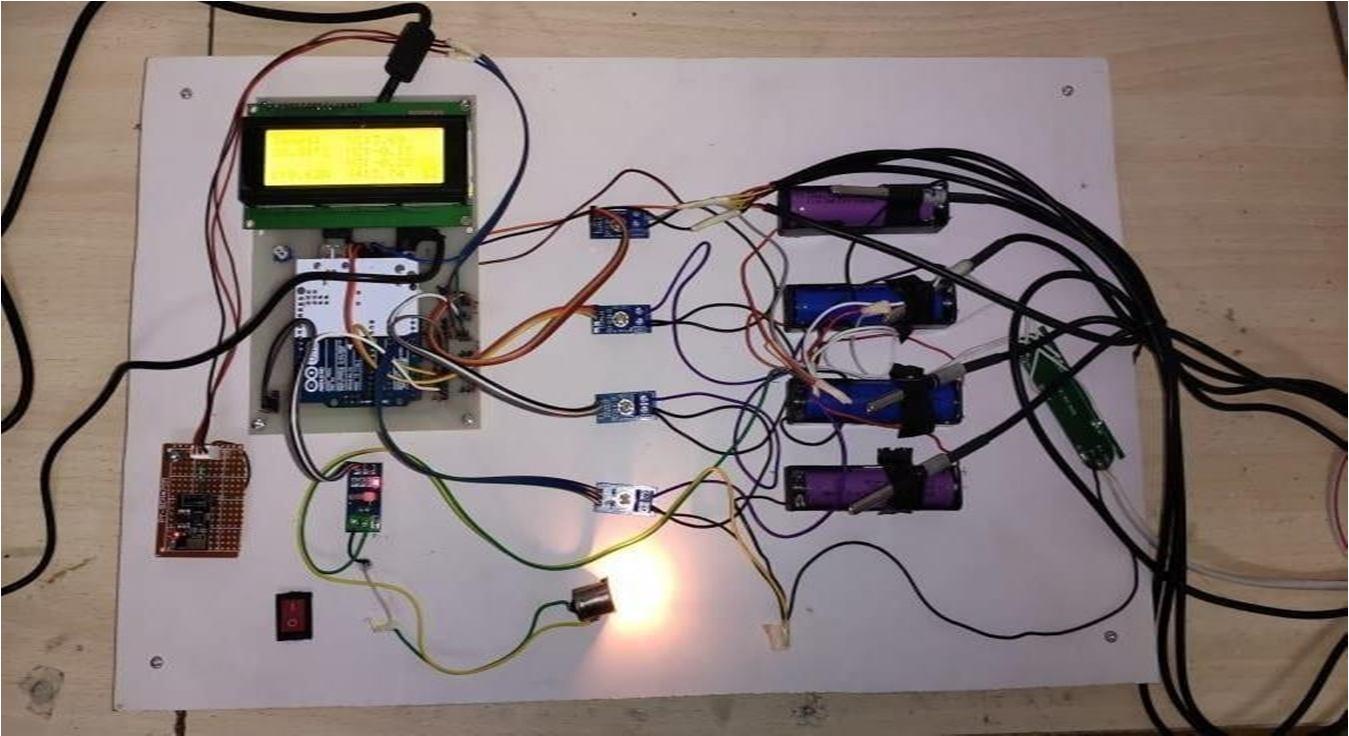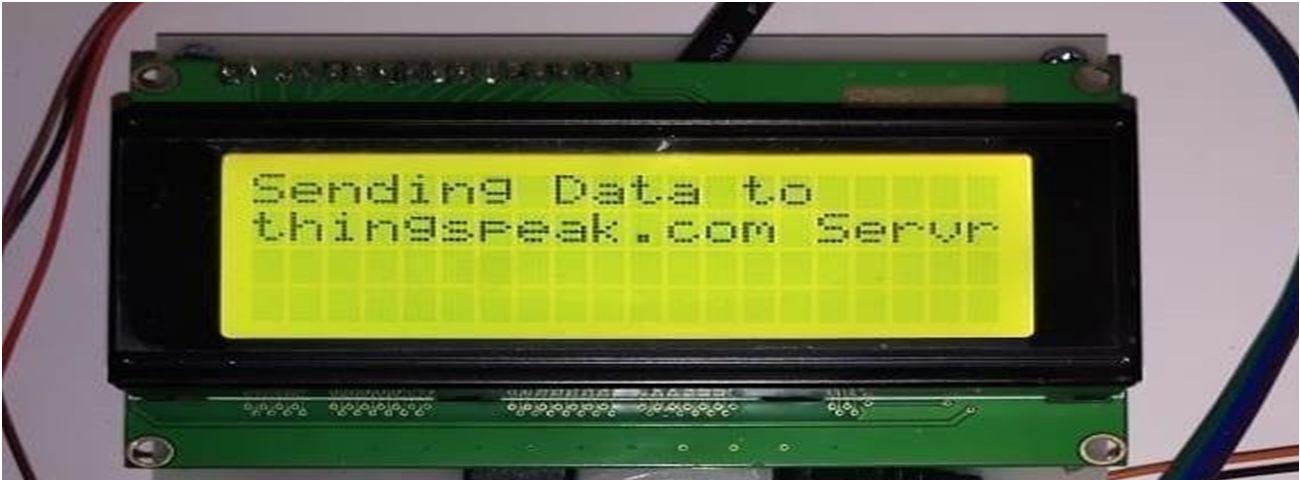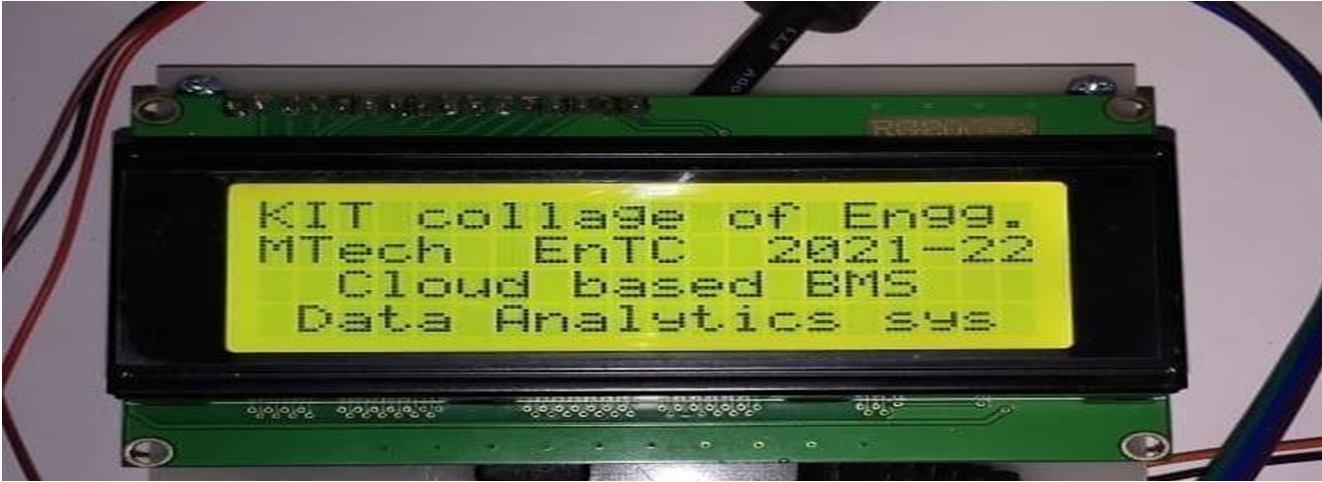

Cloud Based BMS Data Analytics System for EV using IOT
of Electronics
Abstract: The electric vehicle market in India appears to be gaining traction. The automobile industry is shifting to EV manufacturing, as the fuel is expensive and there is global pressure to reduce carbon footprint. There is necessity to improve the current technology and performance of electric vehicles. The continuous monitoring of EV battery for customer safety against accident due to batteryfailure is vital. There isa need to improvebattery analysis andmonitoring to improve EV performance. The cloud based BMS system for EV data analysis using IoT is an ongoing monitoring system for battery performance analysis. Along with this the system provides performance analysis of each EV battery, supplied by battery manufacture. The EV manufacturing is at its early stage, in comparison with fossil fuel vehicles. This maturity in fossil fuel engine has come long way by experimentation, experience, and revolutionary inventions as well stringent norms of government authorities like Euro/Bharat stage 6 etc. The consistent improvement in battery technology is a way ahead for successful deployment of EV. Therefore, continuous monitoring of battery performance parameter is essential which should help battery manufacture to estimate accurately the battery model, state of charge, state of health etc. It will also help to correctly predict possibility of accidents due to improper charging and discharging of battery and estimate of EV.

Keywords: IOT, THINGSPEAK, EV, BMS, Euro/Bharat Stage 6
I. INTRODUCTION
The advancement in cloud computing along with internet of things (IOT) has provided a promising opportunity to resoluteness the challenges caused by the increasing transportation issues. Advancement in the field of Internet of Things and cloud computing has given an opportunity of continues monitoring of data of electric vehicles along with its analyzingand graphical visualization. This system is one of the realistic applications of cloud computing and IOT of monitoring and analyzing the performance parameter of electric vehicles battery.
Electric vehicles depend on the battery as a source of power. However, improper battery charging cycles (during lifetime) gradually reduce battery performance. This is a major concern for battery design in terms of taking full advantage of the potential battery life, and the best performance possible. Improper battery handling can lead to permanent damage or deterioration of the battery. The plan proposes a concept to monitor battery performance, using IoT cloud techniques, so that battery monitoring can be done using the thingspeak IoT Cloud channel that works for EV builder and battery manufacturer The Cloud based BMS data analytics system consists of two major parts: i) Collecting performance parameter of EV’s Battery by communicating with BMS ii) Aggregating, uploading performance parameters data onto cloud, and analyzing data to identify best performing battery. Based on performance parameter analysis, the system is capable to detect degradation in battery performance [2]. Based on battery’s overall performance the EV manufacture can rate the battery suppliers. This project presents the cloud computing & IOT based system designed for monitoring & sending the parameters of the EV, opportunistically to cloud, through the Wi Fi Module. This system aims to provide safety to the customer along with analysis of batteries supplied by different battery supplier. The performance analysis finds the best battery supplier and improving performance of batteriessupplier by other manufactures ifneeded.
provided byCloud Based BMS
EV using IOT:

Sayali A. Patil1 , Prof. Atul R. Nigavekar
Engineering, Kit’s College of Engineering (Autonomous), Kolhapur
ISSN: 2321 9653; IC Value: 45.98; SJ Impact Factor: 7.538 Volume 10 Issue IX Sep 2022 Available at www.ijraset.com

EXISTING SYSTEM

BMS plays a vital part in
battery
power, is the only source
elements.
1: Current BMS operation inside EV
safe operation, and energy usage optimization.
depicted in Figure [1]. The traction battery, which has a sizable capacity and
operates primarily in two different modes: charging and discharging. It operates

(while in discharge mode). The vehicle's wheels receive
meets the remaining onboard power needs for things like air
have
discussions on various hybridpower train configurations

ISSN: 2321 9653; IC Value:
Impact
at www.ijraset.com

III. PROPOSED SYSTEM




In this project, the main objectives of the proposed work are to monitor performance parameters of the lithium ion battery cells and to load the performance parameters onto thingspeak web page. The microcontroller is the heart of the system; we have used the Arduino UNO as a microcontroller. The main advantage of using Arduino UNO is it has inbuilt multichannel, 10 bit analog to digital converter (ADC). There are total four voltage sensor module and four temperature sensors along with one current sensor module.
As the output of thefour voltages sensors and a current sensor is in analog form so it cannot be directly interfaced to the Arduino UNO digital input pins. Therefore, the output of the voltage sensors’ module and a current sensor module are connected to 5 ADC input pins. The DS18B20 is a single wire digital temperature sensor, so its output is directly connected to the Arduino UNO digital input line. Four temperature sensors are connected to a single wire and this single wire is further connected to microcontroller Arduino UNO digital input pins. To displaythe performance parameter of the lithium ion battery cell the Arduino Uno is connected 20X4 LCD display. Wi Fi module sends the parameters to the thingspeak cloud. This Wi Fi module is interfaced to Arduino to collect the parameters The ESP8266 is connected to the Internet for uploading performance parameter. The thingspeak is the IoT service we used which has 8 channels.

ISSN:




www.ijraset.com


Science
Engineering Technology (IJRASET

ISSN: 2321 9653; IC Value: 45.98; SJ Impact Factor: 7.538
Volume 10 Issue IX Sep 2022 Available at www.ijraset.com
2) Current Sensor: This system uses the current sensor ACS172, which has analog output. The load (Bulb) is connected in series with the sensor. This sensor accurately calculates the current of lithium ion cell. As this sensor output is analog so it is converted digital form byapplying it to one of the ADC pins of Arduino UNO.
3) Voltage sensors: One of the performance parameters that we have calculated is voltage of lithium ion cells; this is achievedby voltage sensor module. As there are total four lithium ion cells used in this system, across each lithium ion cell a voltage sensor is connected to measure operating voltage of each cell. This operating voltage output at each voltage sensor is then applied to ADC pins of Arduino to convert it into digital form. Then these parameters areuploaded on webpage.
4) HX 4S 01 (BMS): The HX 4S 01 is a battery management system/charge protection circuit. This charge protection circuit provides over charge, over discharge, short circuit protection, over current protection. This chip is connected to four lithium ion cell in series to increase the life of lithium ion cell by protecting their charging cycles. This chip is low cost, small size also this has high performance
5) Temperature Sensor: The temperature sensor used in this proposed work is DS18B20 which is 1 wire digital sensor. There are four temperature sensors, which are mounted on each lithium ion cell to measure their temperature. As this sensor has digital output soit is connected todigitalinputpin ofArduino.
6) Lithium ion Cell: The system battery is of 14.8v which is formed by connecting four 3.7v lithium ion cells in series with each other. These cells are of 3.7vand 2200mAHcurrent.
7) Thingspeak (IOT): The thingspeak is a service of IOT which is free of cost and provides analysis, monitoring in graphical format. With the help of Wi Fi module Arduino can access internet, so Arduino transfer the performance parameter of each lithium ion cell onto thingspeak webpage. This webpage has 8 data channels The battery parametersare graphicallyrepresented on thingspeak webpage.
8) LCD Display: This system consists of 20X4 LCD display. This display is interfaced with Arduino to display performance parameter of lithium ion cell
9) Wi Fi Module: This ESP8266 module is interfaced with Arduino with objective that Arduino can have internet access to transfer the performance parameters of the battery under monitoring tothingspeak data channels.
A. System Operation
1) First step is to turn on the power supply. After turning on power supplythe LCD will displaythe general details of the project. Then the system connects the ESP8266 Wi Fi module to the internet so that it can transfer the parameter to thingspeak IOT webpage.
2) The four temperature sensor are mounted on lithium ion cell. So that the temperature of battery cell can be measured accurately. All temperature sensors bus slaves are connected to a single digital input pin of Arduino which is bus master using 1 wire bus protocol of DS18B20 (1 wire digital temperature sensor)
3) Each voltage sensor connected across lithium ion cell; this will measure the voltage of each cell. The voltage is calculated in programmatically form by subtracting the previous cells voltage from overall batteryvoltage.
4) The current sensor module is connected in series with four lithium ion cellsand theload (bulb). A switch is connected to turn on off the bulb. According to load conditions the current value will vary
5) All the values of voltage and current sensor module is in analog form so it is given to the ADC of Arduino UNO, it will convert all analog parameter in digital values. The temperature sensor is bydefault digital, so it directly interfaced digital input pin of Arduino UNO.
6) The Arduino UNO is interfaced with LCD and ESR8266 Wi Fi module. The Arduino UNO willtransfer the performance parameter to both LCD and Wi Fimodule as theyare output devices.
7) The LCD will displayvoltage, current and temperature ofeach lithium ion cell.
8) After every20 sec the data will be transferred to IOT thingspeak webpage, and the data is represented in graphicallymanner.
IV. IMPLEMENTAION

1) Step 1 Installthingspeak libraries on PC.
2) Step 2 Createanewaccount onThingspeak. Forthe purpose, go tothingspeak.comand create user account.
















ISSN: 2321 9653; IC Value: 45.98; SJ Impact Factor: 7.538

Volume 10 Issue IX Sep 2022 Available at www.ijraset.com
A. MQTT Protocol:
Thingspeak uses the MQTT API to update Thingspeak channels. The Thingspeak IoT platform enables clients to update and receive updates from channel feeds via the Thingspeak MQTT broker. MQTT is a publish/subscribe communication protocol that uses TCP/IP sockets or Web Socket. MQTT over Web Socket can be secured with SSL. A client device connects to the MQTT broker and can publish to a channel or subscribe to updates from that channel.
Publish
Publish to a Channel Feed
A.
Publish to a Channel Field Feed
Publish message to update multiple channel fields simultaneously with MQTT
Publish message to update single channel field with MQTT

Subscribe
Subscribe to a Channel Feed
Subscribe to a Channel Field Feed
Subscribe to updates from channel feed with MQTT
Subscribe to channel updates from specific field of channel with MQTT V. TESTING RESULT

Figure 10: Graphical Representation of voltage of Lithium ion cells
The above screenshot represents graphical representation of the voltage parameter of lithium ion cell. The x axis represents date and y axis represents the battery voltage. This voltage is the real time voltage of lithium ion cell calculated by voltage sensor and BMS. By continues monitoring of this voltage the lithium ion cell can be protected from hazardous effect and increase their lifetime.

Figure 11: Graphical Representation of temperature of Lithium ion cells
The
Figure 12: Graphical Representation of current Lithium ion Cells


The






International Journal for Research in Applied Science & Engineering Technology (IJRASET)

ISSN: 2321 9653; IC Value: 45.98; SJ Impact Factor: 7.538
Volume 10 Issue IX Sep 2022 Available at www.ijraset.com
VIII. CONCLUSION

The main objective of the system is, continues monitoring of EV performance parameters through thingspeak IOT webpage This is achieved by using Arduino UNO. We can easily interface the different sensors connected to lithium ion cells to build in ADC of Arduino. These parameters are essential for analyzing the performance of electric vehicle. That’s why it is necessary to continuously monitor the parameters. This continuous parameter monitoring is achieved with the help of internet of things (IOT) and Wi Fi module. Then with the help of Arduino UNO this parameter will get uploaded on webpage of IOT. The IOT webpage graphically represents the performance parameter of each lithium ion cell.
REFERENCES
[1] Hossam A. Gabbar, Ahmed M. Othman “Review of Battery Management System (BMS) Development and Industrial Standards” MDPI Published 11April 2021
[2] Julio A. Sanguesa 1, Vicente Torres Sanz “A Review on Electric Vehicles: Technologies and challenges”, © 2021 by the authors. Licensee MDPI Published: 15 March 2021
[3] Shabana Urooj 1 , Fadwa Alrowais “ IOT Based Electric Vehicle Application Using Boosting Algorithm for Smart Cities” Published: 18 February 2021
[4] Anjali Vekhande, Ashish Maske“iot based battery parameter monitoring system for electric vehicle” IJCRT | Volume 8, Issue 7 July 2020
[5] Nikita N. Mutrak1,Kaveri Pagar 2 “IoT based Battery Monitoring System” International ResearchJournal of Engineering and Technology (IRJET) e ISSN: 2395 0056 Volume: 07 Issue:06 |June 2020 www.irjet.net p ISSN:2395 0072
[6] R. M. Vethekar1 , A.B Chandgude “Review on IOT based electric vehicle battery management system using LAB View” International Journal of FutureGeneration Communication andNetworking Vol. 13
[7] Mohd Helmy Abd Wahab*,1,5 , Nur Imanina Mohamad Anuar “IOT based battery monitoring system for Electric Vehicle” International Journal of Engineering & TechnologyInternational Journal of Engineering &Technology, January 2018
[8] Harish N1 , Prashal V2 “IOT Based Battery Management System” International Journal of Applied Engineering Research ISSN 0973 4562 Volume 13, Number 8 (2018) pp.5711 5714
[9] Jose A. Afonso, Joao C. Ferreir “IoT System for Anytime/Anywhere Monitoring & control of vehicle Parameters” 2017 IEEE International Conference on Service Operations and Logistics, and Information September 2017
[10] Koko Friansa1 , Irsyad Nashirul Haq2 “Development of Battery Monitoring System in Smart Microgrid based on Internet of Things (IOT)” ScienceDirect 2017

